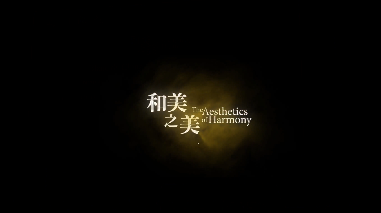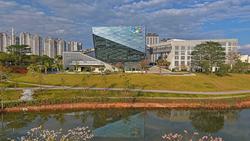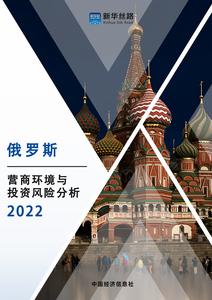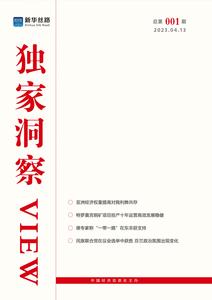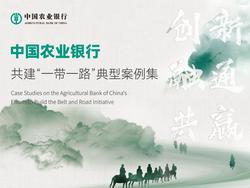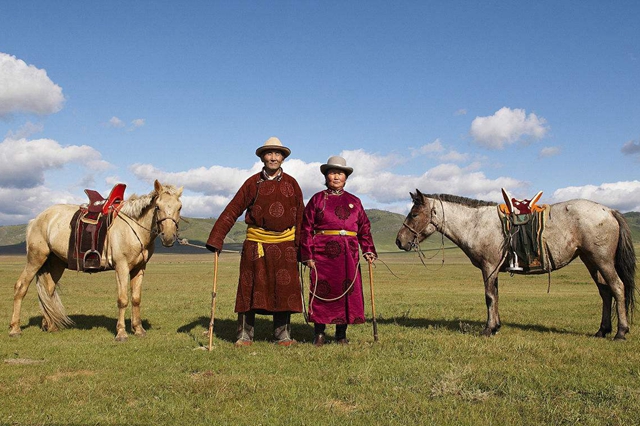
In the 17th century, Luobusangdanjin and Sagangchechen, two outstanding historians of Ordos, published their masterpieces: History of Golden Family and Origin of Mongolia. The monumental works, together with Secret History of Mongols, are considered as three historical records of utmost importance on Mongolian. They represent Ordos’s glory and an immortal milestone in the city’s history.
Ordos carries weight in Mongolian cultural history. In the latter half of the 16th century, good relations between Ming and Mongolia brought lasting peace and stability to Ordos. It also contributed to cultural exchange and development. Back then, Lamaism possessed widespread popularity. Large quantities of Zhao Temples (places where Lamaism believers pray) were constructed and the advancement of Zhao Temple culture gave birth to a new generation of intellectuals in Ordos. In addition to History of Golden Family and Origin of Mongolia, An Outline in Golden Family’s History and Genghis Khan and His Descendants by unknown authors, published in Ordos in the 17th century, are masterpieces of Mongolian history as well. It showed that Ordos’s people, the guardians of Genghis Khan’s Mausoleum, started to reflect on their history, study Mongolian history and spiritual legacies at that time. As a group of valiant and intelligent people, Ordos took on their responsibility to probe into and inherit their history and culture. Hence, it was not a coincidence that great historians like Luobusangdanjin and Sagangchechen emerged in the city.
A magnificent Zhao Temple, AshiQuanlin, once stood on a sloping field on the west bank of Buersitai River in Zhonghexi Town of Dalad Banner. The author of History of Golden Family, Luobusangdanjin, was the first Living Buddha in Zhaodongzhao, Ashiquanlin. It was also where the book was completed.
“Ashi Quanlin” was transliterated from Tibetan. “Ashi” meant “auspicious” and the latter half implies “Buddhist scripture library”. The construction of the temple started in 1587 and its main hall had 81 rooms at its peak. Besides, there were more than 1,000 monks, several side halls, dozens of tiny affiliated temples and white pagodas. For hundreds of years, there was an endless stream of worshippers coming to AshiQuanlin. In 1689, the expansion of the temple was carried out in the charge of Luobusangdanjin, when printing of Mongolian and Tibetan scriptures made its reputation as the “Buddhist scripture library”. It was a pity that the whole temple was dismantled in the Cultural Revolution. Those bricks and wood had been used to build commune institutions along with supply and marketing cooperatives. AshiQuanlin was situated in Muye Village.
Zheng Si, the village chief, recalls that he could hear wind chimes from 46 temple towers, the highest of which was 36 meters, when he was a child. The only one that survives until today is Agui Temple underground. Decrepit bricks and tiles are scattered on the hills in the village. The only part of the stone columns that remains is their pedestals. In the past, the Living Buddha could savor the spring water dripping down the colossal rock on Agui Temple. Today, all visitors can drink it. Pondering over the mysteries and glory hidden in the dilapidation and desolation of Agui Temple, one cannot help feel its solemnity with admiration.
As many as 300 years ago, Luobusangdanjin chanted Buddhist scriptures and wrote his great work next to the fountain as he relished in a stone cave. Time flew by but his masterpiece continued and the culture was never interrupted. So far, there has been no consensus on the historian’s years of birth and death. According to the result from a field investigation made by Antoine Mostaert, a Belgian priest and renowned scholar, on the study of Mongolia, Luobusangdanjin was born in 1649 and died in 1736. After he passed away, hlics were kept in one of the towers of AshiQuanjin, which were later demolished together with the white tower. However, History of Golden Family continues to live on. His only handwritten copy is in the National Library of Mongolia and Chinese, English, Russian, Japanese and German versions all enjoy popularity.
Muye Village, Zhonghexi Town, Dalad Banner, is planning to revive cultural tourism based on the old AshiQuanlin. A chanting hall, a white tower and several dormitories for monks have already been built. Dozens of monks live in the new temple. Evening drums, morning bells and chanting can be heard every day. Radiant Buddhist culture of AshiQuanlin has ushered in again.
Unlike Luobusangdanjin, Sagangchechen, the author of Origin of Mongolia, was the descendant of the Golden Family (Genghis Khan’s line). His hometown was Uxin Banner, where people have made temples to worship and commemorate the preeminent historian. Lageshengburen, a well-known 66-year-old doctor, has dedicated himself to the study and inheritance of sacrificial culture in the temples for many years. Under his leadership, memorial halls, museums and stupas were built, where regular ceremonies are held in honor of Sagangchechen.
Origin of Mongolia was completed and circulated in handwritten copies among the Mongolians during Qing Dynasty. By a rough estimate, there were over 30 different versions of the book back then. In 1766, Emperor Qianlong ordered it to be translated into Manchu and Chinese. He named the new versions, Origin of Mongolia Made by an Imperial Order. They were then included in Complete Library in Four Sections. At the beginning of the 20th century, the Belgian scholar, Antoine Mostaert, collected three handwritten versions of Origin of Mongolia in Ordos and brought them to the US later. The global academic circle was amazed by these manuscripts and the research Mostaert had done when the relics were made public in America in 1956. Today, there is a Manchu version and a Manchu-Chinese one in the Palace Museum. Besides, in the municipal archive in Ordos there are two Manchu versions of Origin of Mongolia. One of them is especially invaluable as it was transcribed with bamboo pens in the Qing Dynasty shortly after the original version was completed.
It goes without saying that Mongolian history has its significance for the Chinese culture and world as a whole. Ordos people, with Luobusangdanjin and Sagangchechen being the most distinguished representatives, are recognized by the entire world because of their devotion to and study on the Mongolian history. It is their sense of mission with historic profoundness that has been reinforcing their confidence in their culture and has made contributions to inheriting the Mongolian culture. The composition and spread of History of Golden Family and Origin of Mongolia were closely connected with Lamaism. The strong influence Lamaism exerted on the authors can be seen in their works. Lamaism still permeates in the lives of Ordos people. For instance, many Mongolian names have been transliterated from Tibetan, such as Rangwadi, Naogaosang, etc. In fact, it is the exchange and blending of Mongol culture, Lamaism and Western-Gate Culture (Western-Gate is a region in Northern China of which Ordos is a part) that gave birth to the one of a kind regional culture of Ordos.
Ordos people absorbed external cultures, delved into Mongolian history and culture with a noble sense of responsibility and inherited and spread their own culture with firm belief. Ordos culture is thus dynamic and ever-growing. This confidence in culture needs to be passed on to the future generations in Ordos. When appreciating two monumental works and absorbing ourselves in Mongolian history, we are being inspired to dig into and pass on Ordos’s long-standing culture and history so that the regional culture can keep up with the times.
In order to orient Ordos’ development in a global direction and push it to a higher level, we need to look back on the roads we have taken. Rational thinking is beneficial in viewing the history as it also contributes to the succession of Ordos’s qualities of openness, inclusiveness, honesty, kindness, hard work, innovation, unswerving determination, ever-lasting diligence and unrelenting pursuit. Meanwhile, the confidence in the city’s culture should be boosted. People can forge ahead with their past in mind and pen a brand new chapter in Ordos’s history.



